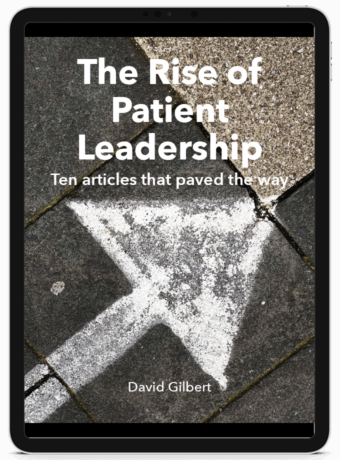Patient Leadership Could Help Solve Workforce Issues
The Patient and Public Engagement industry has been sidetracked.
For many years, patients, users and carers have been led to believe that their voice matters. And that by taking part in focus groups, telling emotional stories at conferences and being a ‘representative’ they will make a difference and that this translates to being ‘at the centre of the NHS’.
I have long argued that these transactional engagement approaches are outmoded, preserve the status quo and buffer us from power. See for example this article
At the HSJ Summit on Mental Health, I was reminded of two further things. Firstly, that you need to sell your work as relevant – “if the next government believes in choice rather than rights around mental health, use the argument of choice… you can sell the same thing”. Secondly, speaker after speaker said it was workforce issues that kept them up at night.
So, we need to sell co-production as a workforce issue.
Of course, it is other things too. It improves outcomes and experience. It helps with improvement and transformation. It shifts power (don’t shout too much about that one, sneak it in).
How is co-production a workforce issue?
Well, firstly, there are three embedded models of co-production doing the rounds that I rather like. One of course is our Sussex Model of Patient Partnership, based on a triangular dynamic between the role of a Patient Director (critical I think), pool of Patient/User/Carer Partners involved in improvement and governance and a Patient and Carer Forum with formal oversight for patient experience and engagement work as well as other things.
The second one is outlined in the book, The Patient Revolution. Karen Owen’s chapter on HealthMakers describes a model whereby people who have been self-managing their own condition (of whatever sort) can become peer support workers and then enter the strategic realm should they wish.
Meanwhile, in mental health, the rise of peer support work as an acknowledged paid role (albeit often poorly paid) offers rich opportunities. For example, Central and North West London (CNWL) Foundation Trust is putting in place an integrated approach and thinking through how already embedded peer worker skills can be extended so that people take on other roles (coordinated by Melanie Anne Ball, their Trust-wide Peer Support Lead) (@melanieanneball).
What all these have in common are:
- Valuing the wisdom and expertise of what we bring – the jewels of wisdom and insight from the caves of suffering
- Creating new roles and opportunities for people affected by life-changing illness, injury or disability
- Developing embedded approaches that align with corporate priorities
- Allowing people affected by IID to more directly assist in improvement work
- Supporting ‘career’ progression
- Building capacity and capability alongside development of roles
- Implicitly changing and transforming the traditional ways of doing engagement work
- They are applicable across all health settings - mental, community, acute - and across all sorts of local organisations (provider, commissioner) and national level (regulatory, policy-making, NHS England, etc).
Peer support helps deliver services. Patient Partners involved in improvement and governance helps drive change. These two elements need to link up.
I would propose that every health and social care organisation looks at these three models. And with the help of people like us (Lived Experience Practitioners, Experts by Experience, Patient Leaders – call us what you will) develop integrated approaches to co-production.
But here’s the crunch: Workforce shortages and resource pressures mean that co-production could really help.
I am not advocating for cheap peer support to displace roles that should be done by others. I am arguing that at each stage along this new ‘career pathway’, this work can help….
- By designing better and more coherent self-management programmes, co-facilitated and driven by Patient Leaders, etc. This would stop attrition rates in professionally designed and driven programmes, and have long-term consequences for well-being.
- By having a high quality peer-support workforce (able to offer ‘health coaching’ skills and/or signposting to well-being functions) this obviously helps improve outcomes and experiences.
- By developing improvement roles so that patients become, for example QI partners and improvement advisers, we would better target and implement co-designed interventions. They would better focus on what matters.
- By having patient leaders in governance roles, there would be enhanced accountability and better quality decision making.
- By having a Patient Director role, the work above would be co-ordinated and would actually happen.All this would help improve outcomes and people’s experiences as well as have deeper effects on quality of decisions and delivery. This work helps staff.
Another benefit of true co-production (that I have seen time and time again) is that staff morale lifts and through the presence of patient/user work, staff become re-connected to the passion and values that brought them into the work in the first place. This work rehumanises healthcare. This work helps staff.
Good engagement impacts upon staff engagement and staff well-being. This might have – a hunch, but a strong one – a significant impact on recruitment and retention. This work helps staff.
Bureaucracy and the chasing of frenzied regulatory targets reduces – this is also a hunch at the moment, but I am seeing it happen in a few places – patients in more control of decision making ensures a focus on measuring and working on what matters. We need to reinvigorate the workforce with a cultural transformation that focuses on what matters. This work helps staff.
And if this happens in commissioning and regulation, at policy and practice level, we have a true patient revolution on our hands. This work helps staff. It transforms cultures in ways that all the empty rhetoric at well-meaning conferences fails to do - because the same old tired people are in charge (I mean well, some of them are very good!).
This work helps the chief executive. Our dream of patient leadership turned into everyday practice might allow a chief executive to be released from their nightmares. Remember, they come to work because they care too.
Co-production is a workforce issue.
—-
© 2019 David Gilbert
If you liked this blog, please read more at www.futurepatientblog.com
And follow me on Twitter @DavidGilbert43


This is brilliant David and so inspiring!
Although we're doing things bit different and still early days, I think it's good as we can compare outcomes. Pleased we have 15 paid places but we need more structure so it lasts long after I'm gone. Staff do get reconnected, had that happen many times and told the impact it had on them. Very gratifying and vitally important. Dom x